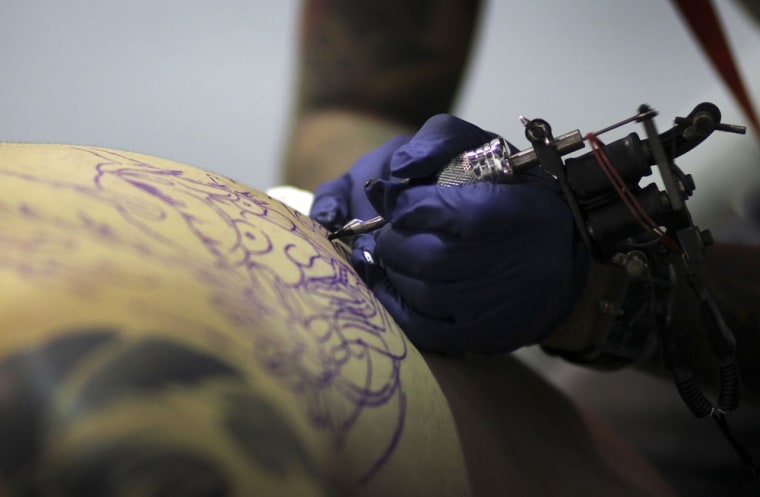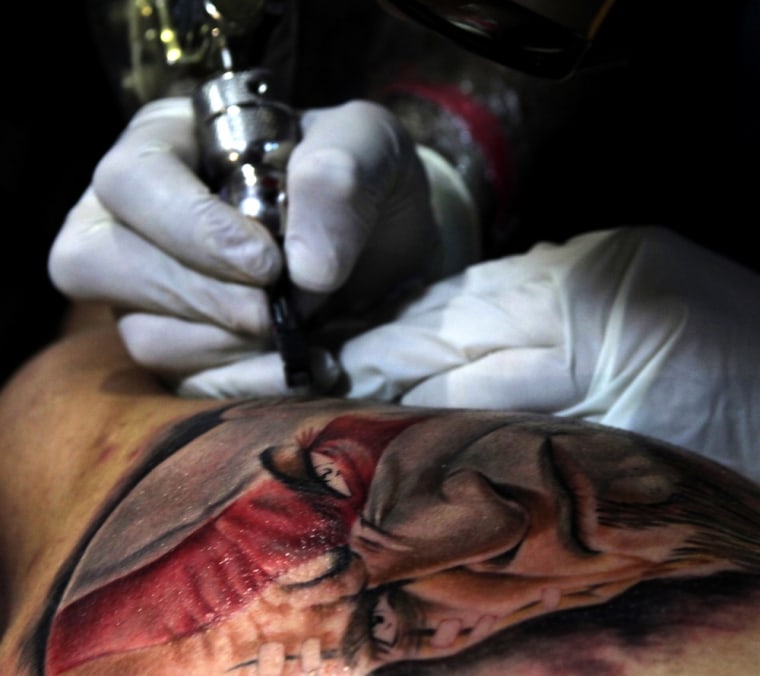A lot of ink has spilled in the media lately about the popularity of tattoos among Americans. Any stigma surrounding the ancient body art has long ago faded. Businesspeople, parents pushing strollers and college students are as likely to sport "tats" these days as the traditional clientele of military personnel or bikers.
No exact figures are available that outline the size of the tattoo industry in the U.S., but several years ago Inc. estimated there were about 15,000 tattoo parlors in America, making somewhere north of $2.3 billion annually. And a Pew Research Center study says more than a third of Americans ages 18 to 25 have a tattoo, as well as 40 percent of folks in the 26 to 40 range. In contrast, the study found only about 10 percent of people age 41 to 64 are tattooed.
Another interesting note: Many tattoo businesses appear to be doing quite well, thank you, in spite of the economic downturn. "Things like tattoos, alcohol, entertainment — they're always going to be there," says Joe Miller, owner of Old Larimer Street Tattoo in Denver. "They make people feel good about themselves."
Miller says in November of 2008, "when things really hit hard in the stock market, I actually had one of the best Novembers of my career." He opened his high-end shop on Larimer Street a year later and has still found business to be good.
At the least, it's recession-resistant
Even as the stock market was bottoming, he remembers, "a couple came in, and they both got very large, very expensive tattoos from me. The recession was a big topic back then, and they started talking. And they were like, 'Well, we lost about a quarter-million dollars in the past week, so what's another two-thousand?' I wouldn't say our industry is recession-proof," he says, "but it's definitely a lot more resistant than other luxury industries."
Tattoo artists usually work on commission, giving 40 percent or more of their fee to the shop owner. Miller estimates that by working his own business with a partner, he's doubled his earlier income and is currently taking home about $125,000 annually.
Miller's career may be the exception, however. He says his tattoo artist colleagues average about $50,000 a year, and a good number scrape by on less than half that. "I have friends just getting into the industry that are starving," he says. But the tattoo business is definitely tilting in favor of upscale clients. In another part of Denver, Th'ink Tank Tattoo owner Scottie DeVille has nine artists on staff, up from four when he started the shop in 2002. "Since we've opened, our profits have increased about 10 percent per year," DeVille says in an e-mail. "In 2008, the average hourly [rate per artist] was $120. Today the average is $150."

When inspiration turns to regret
Some in the tattoo business believe the boom is due in part to a more professional generation of trained artists doing better work. But Miller notes that in the past three to four years, his clientele has included a growing number of middle-age suburbanites. "A lot of tattoo artists like to attribute [the increase to] reality-TV tattoo shows," he says. "Of course, they bad-mouth [these shows], but the reality [is they] took the tattoo industry to a whole other demographic. That person watching TV, that normally would never even think about getting a tattoo, is all of the sudden like, 'you know what? I want to do that.' It inspires them."
Of course, that inspiration sometimes turns into regret. The American Academy of Dermatology points to a 2004 survey, which found nearly one-fifth of people with tattoos had considered getting their body art removed. And the costs of turning that tattoo into a distant memory aren't cheap. "Our average client spends between $800 and $1,200 to get a tattoo removed," says Shelley Novello, founder and CEO of Ink-B-Gone Precision Laser Tattoo Removal. "The typical tattoo takes about a year-and-a-half to remove. Some come out in one time. Most take closer to five or six treatments." Novello says her Denver offices see about 200 people a month.
"I began my business because I was watching my older teenage children start to put tattoos on," she says, "and I started to wonder how are they going to get a real job some day, with ink showing from their elbows down." Novello signed up for classes in laser removal of tattoos and started a new career. "There were a couple of places in town that offered tattoo removal [but were] extremely expensive," she says. "So I thought, where do the normal people go? And there really wasn't an option. So I threw together a business plan, cashed-out my 401(k) and quit my real job — and that was almost five years ago."
Business, she says, is doing well — although she's currently operating at about 30 percent of capacity. "Tattoo removal is probably at the very bottom of most people's priority lists when they have to make a car payment or buy groceries," she says. "So like most of the other personal-service industries we had a rough year-and-a-half."
'Perfect alignment of the planets'
But Novello is still banking on the fact that a lot of people seem to suffer from "tattoo remorse" as they get older. Her typical client is between the age of 28 and 35, middle class, professional — and equally divided between women and men.
"You see all these tattoos running around, and you think tattoo removal must be such a lucrative business right now," she says. "But really it [takes an] almost perfect alignment of the planets. You've got to get somebody that hates their tattoos enough, that's willing to come in the front door, that's willing to go through the time it takes, that's willing to spend money. It's almost like a perfect storm that has to happen, to get that client to come through the door."
Right now, the winds seem to be blowing far more people into doors of tattoo artists' shops.
